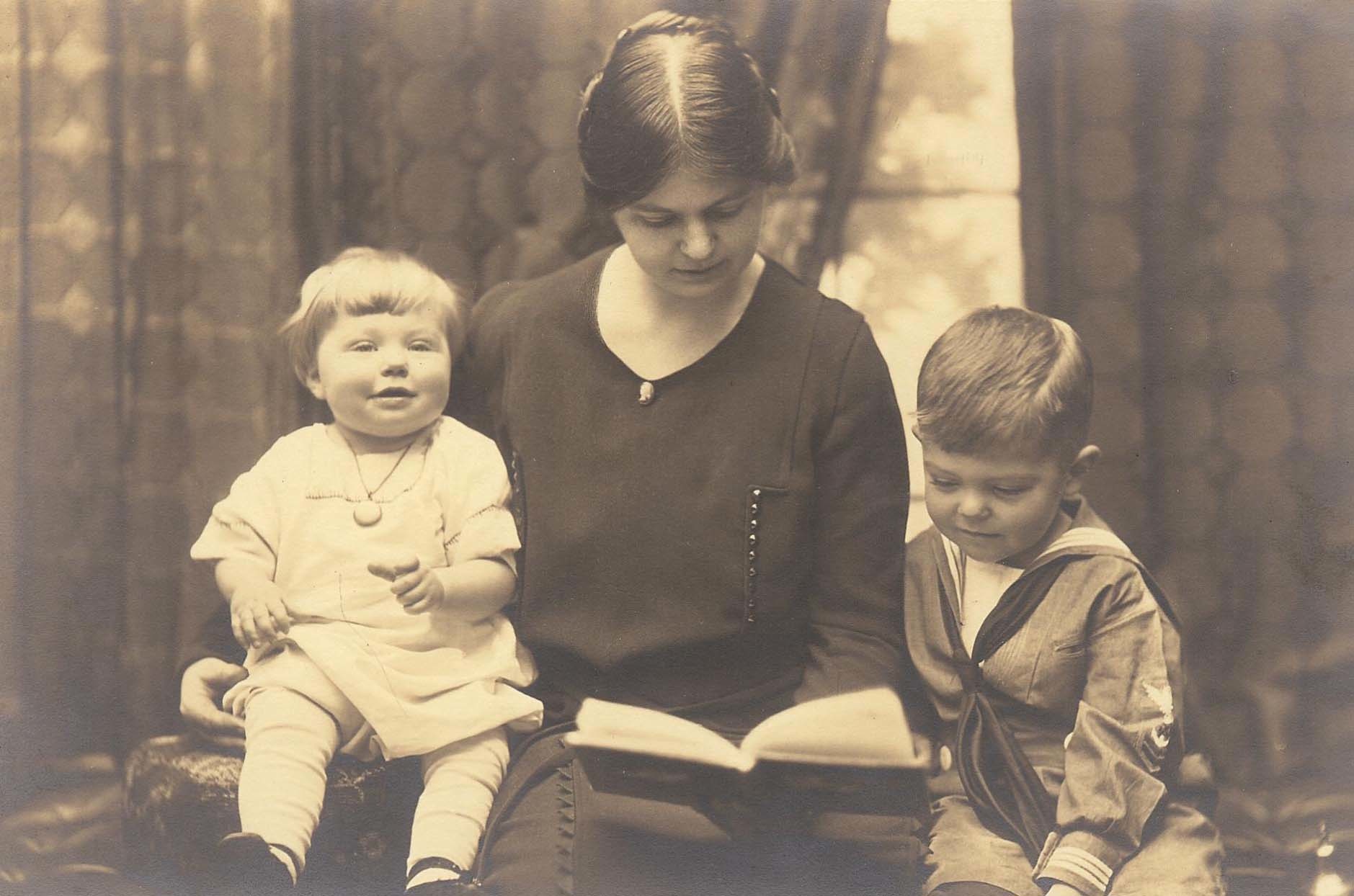
About 1921- John and sister Helen with their mother, Helen Hunt Crowell.
John J Chambers Crowell passed away on May 13th, an hour into his 99th year.
Santa Barbara News Press Obituary.
May 2015,
Because of our families schedule, we celebrate my father’s 98th birthday a week early. On Friday morning, May 5th, I caravan with my husband Art, our two grown children John and Alisha and her two children Molly (8) and Sterling (4) to visit father, grandfather and great grandfather, John C. Crowell for a birthday celebration. For 25 years my father and my mother, before her passing in 2007, have lived at Casa Dorinda, an elegant retirement home in Montecito California. Scott Macklin, my ex husband and his wife Shari drive up from San Diego and the nine of us enjoy two lively and elegant dinners plus a day at the Santa Barbara Zoo with my father. Although dependent on a wheel chain, his spirits are high and his mind sharp and I am ever so grateful to be together.
A week later, on the morning of May 12th, his 98th birthday, my father wakes up with chest pains and we get the worrisome call from the Casa Dorinda Medical center. Art and I drive to Santa Barbara and are at his bedside by 4:00 P.M. that same day but when we arrive, my father is unconscious. We are grateful to have celebrated his auspicious day a week earlier and thankful that we can be with him as he passes in the early morning hours of May 13th.
Naturally, his family and friends mourn his passing but he lived a rich and fulfilling life up until the end and I remind myself that there are few regrets. Because of my father’s scientific fame in geology, planning his memorial is daunting but many of his friends and colleagues at the U.C.S.B. Earth Science department come to my aide in writing his obituary and assist in gathering geological photos and formatting a power point slide presentation for his memorial. A number of his former students and colleagues travel from fields afar to honor my father’s life and his significance in theirs. The staff at Casa Dorinda, the retirement facility that my father called home for nearly 25 years is compassionate and helpful in facilitating the service. My thanks to everyone who touched his life.
June 27th, 2015 – Memorial Celebration – Casa Dorinda, Montecito
So that friends and family may look back on the memorial events honoring my father, compiled here are the photos and the words spoken in my father’s honor.
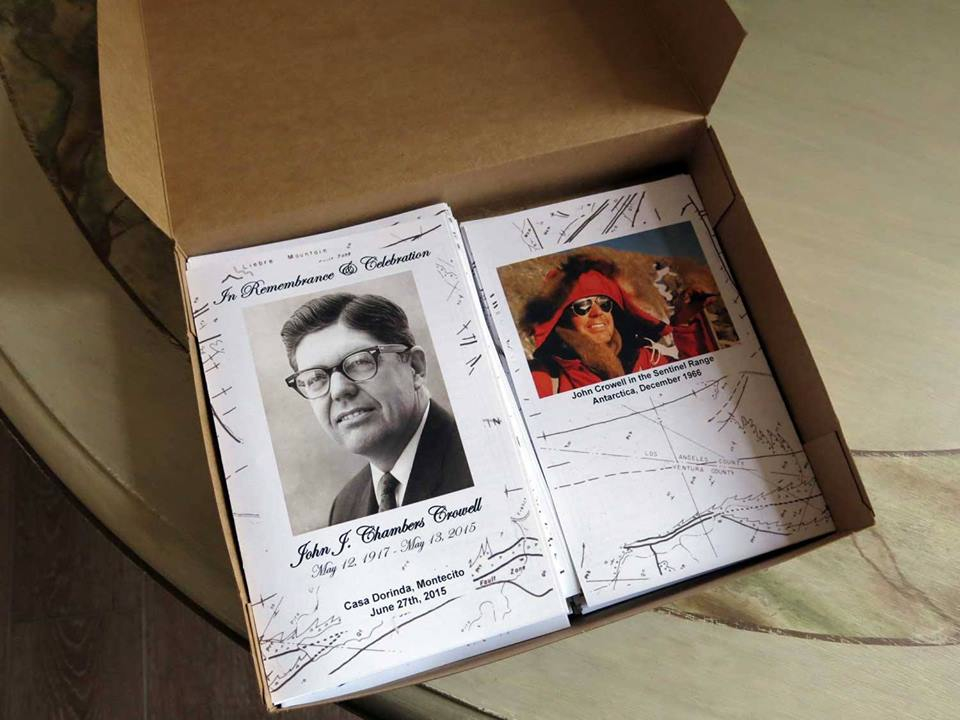
6/27/2015 John Crowell’s Memorial Program
3:00 P.M. Saturday, June 27th, 2015. Guests gather in the music room of Casa Dorinda.
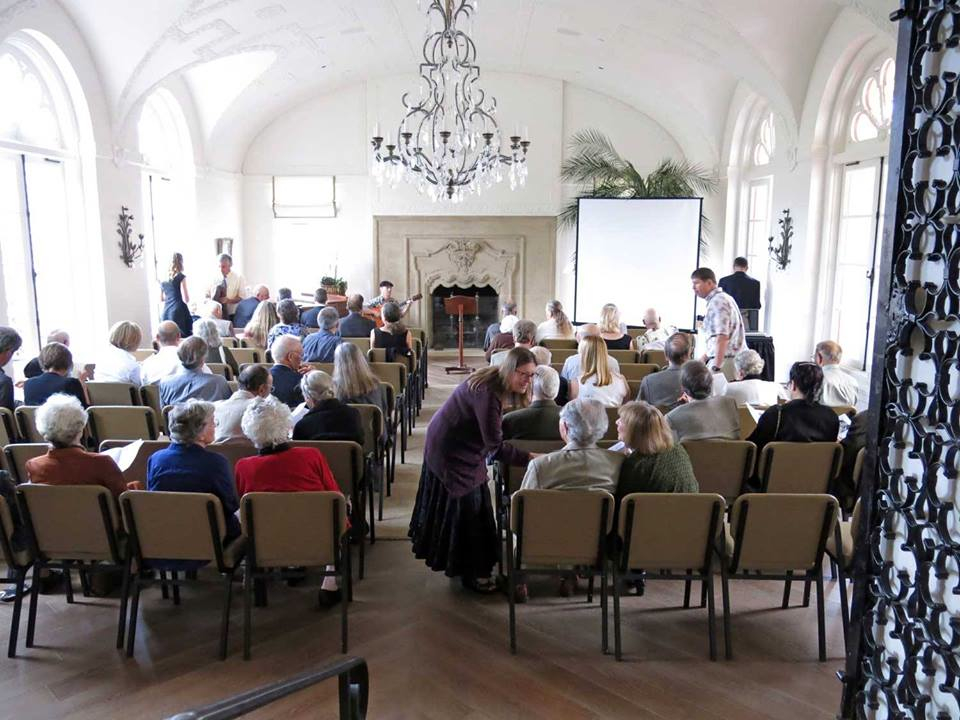
June 27th, 2015 – John Crowell’s Memorial, Music Room, Casa Dorinda
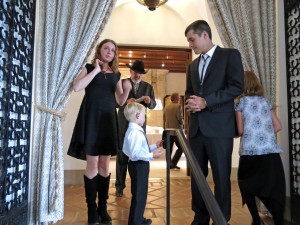
Grandson John Bobroskie, Granddaughter Alisha McCormack.
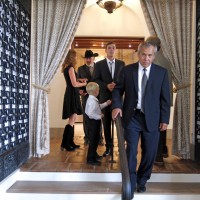
Son in law Art Bobroskie and family.
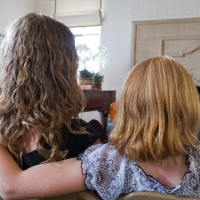
Alisha and Molly McCormack, Granddaughter and Great Granddaughter..
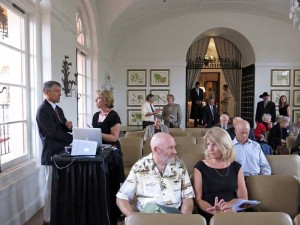
Rob Butler, Linda O’Dean, Andy Wyss, Kate Lima.
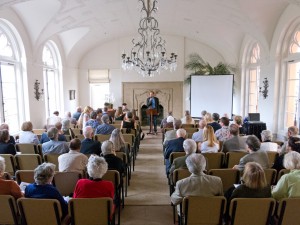
Bill Adkins, Welcoming Prayer
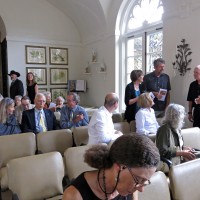
Memorial Guests
Below, Memories of John Bobroskie – Senior at S.F.S.U. and John Crowell’s grandson.
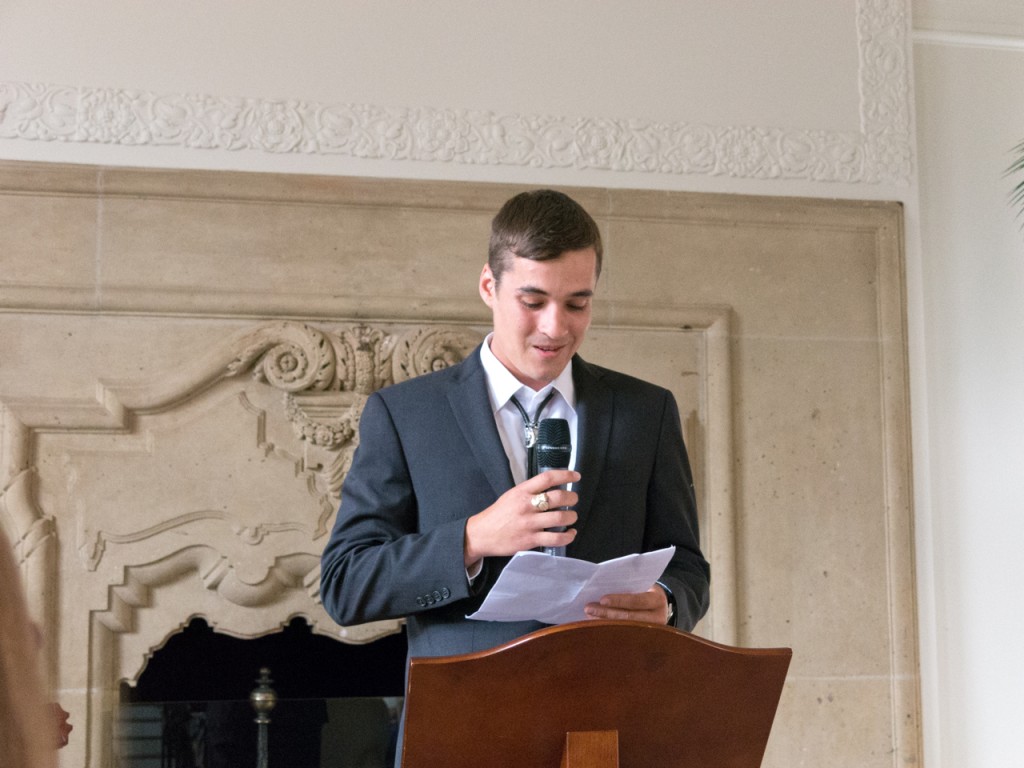
John Bobroskie, John Crowell’s grandson
Hello everyone and thank you all for coming. My name is John Arthur Bobroskie. I am John Chambers Crowell’s grandson and named after both my grandfather and my father, Arthur Bobroskie. I am not sure where to start with this speech so I guess I will start with my earliest memories of him.
When I was younger, my grandparents would visit me a lot in Santa Cruz and I would take hikes with my grandfather along the beach. I especially loved trips with my grandfather to Ano Nuevo state beach to see the elephant seals. Ano Nuevo is strewn with wonderful rocks and I would come home with my pants sagging because my pockets were stuffed full of assorted beach pebbles. After our hikes I would ask my grandfather what types of rocks they were and if they came from a volcano. He would always reply with something over the top of my head but then narrow it down to what I could understand. He taught me the difference between granite and sandstone and if a rock was plutonic or sedimentary. One Christmas when I was about 6 years old my grandfather gave me a box of rock specimens and can still remember the assortment. There were pieces of snowflake obsidian, tigers eye, amethyst and pyrite. I thought they were the coolest things ever and I am still interested and collecting rocks and minerals to this day. My mother, Marty is a jeweler and I have gone with her on buying trips to the Tucson Gem and Mineral show many time. I imagine that my grandfather influenced her career as well.
When I was a kid, my grandfather would read to me and play chess with me and to take us to visit museums, parks and the zoo. As a kid I never quite realized what an extraordinary man my grandfather was but I thought he was pretty cool because he had traveled the world and lived with penguins in Antarctica. Several Christmas’s ago, he gave me the red parka that he wore on his Antarctica expedition. It wasn’t until I was in high school that I understood all that he had actually accomplished from his shell oil career to his military endeavors and the crucial role he played forecasting the weather for the Normandy Invasion in WW ll. I am amazed by his geological accomplishments and all the awards and medals he received over his many years of study and teaching.
Over the past several years I have asked him so many questions, wanting to learn more about his fascinating life. I am very sad that he is gone but grateful that I was able to spend as much time with him as I did and learn as much as I could from him. My grandfather has been a great role model and a big influence in my life. It is because of him, his mentoring and encouragement that I am pursuing a career in Marine Biology.
I can only hope that my life will be half as exciting and fulfilling as his was. He was a loving and remarkable man and grandfather and I will miss him and remember him always.
Below, Memories of Alisha McCormack – Artist and John Crowell’s granddaughter.
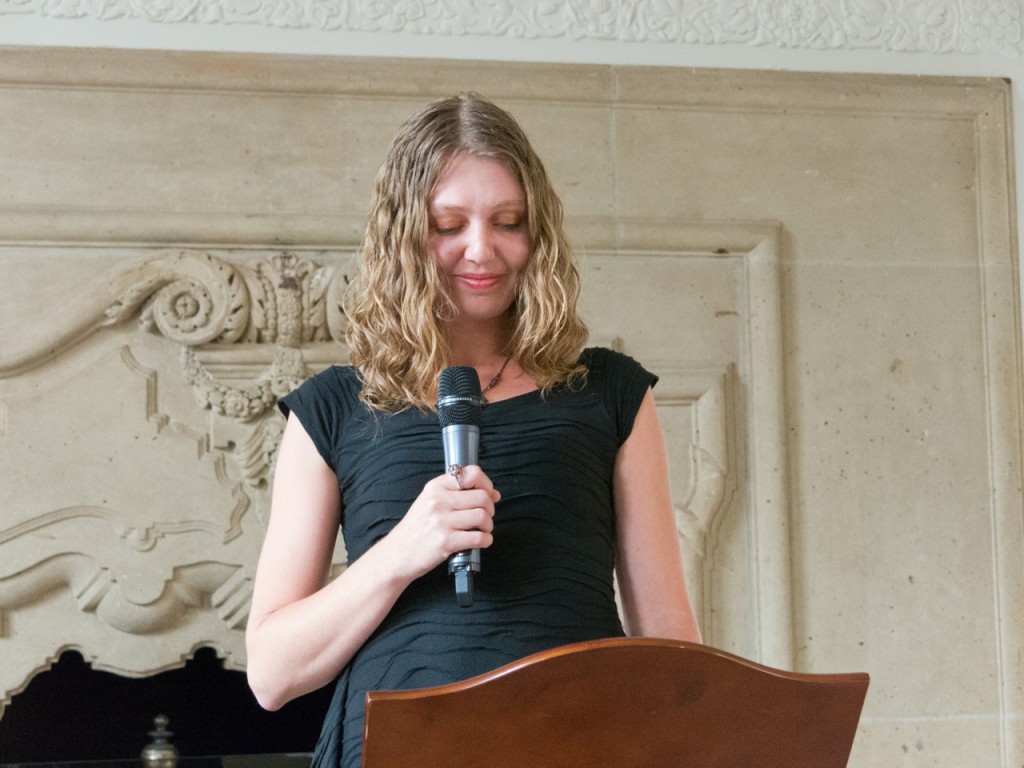
Alisha McCormack, John Crowell’s granddaughter
Hello, My name is Alisha McCormack and I am John Crowell’s granddaughter. My Grandfather was one of the most exceptional people I have ever known. Not only did he have a brilliant mind but also he was an amazing family man. It seems that everything he ever did was to ensure that his family was well taken care of.
When I was very young I spent a lot of time with my grandparents. I remember many afternoons lying on my Grandfather’s study floor pretending I was playing office or teacher, as he worked at his desk. To keep me occupied he would gift me with piles of technical looking scratch paper covered with maps and graphs which I would proudly edit and then return to him. In the late afternoons Grandma and I would often prepare tea parties for grandpa. We would sit together on the patio eating cinnamon toast and drinking hot chocolate out of a penguin pitcher that Grandpa had named Gork. Those were special days. As a little girl I would accompany my grandpa on wonderful hikes down to various creeks in Santa Barbara where we would spend hours stepping from stone to stone searching for little frogs and tadpoles. After collecting them in glass jars we would take them home to Grandma where she and I would create beautiful pond life terrariums. We would enjoy our pets for a few days and then grandpa and I would take the little critters back to their creek and set them free. I will always remember my grandfather’s love for all of God’s creatures. On our walks he would always point out lizards basking on sunny rocks and bunnies and chipmunks scurrying through the grass.
I remember my Grandfather reading Heidi to me several times. I loved the sound of his voice. This book was always one of our favorites seeing that it was about a little girl and her grandfather who lived in the Austrian Alps; a place where my Grandfather lived and studied long before before I was born.
One of our favorite places to go together was the Santa Barbara Museum of Natural History. We would walk through the rooms filled with animals and rocks and dinosaurs and my grandpa would explain to me in detail the story behind each one. It always amazed me how much he knew about everything. As I got older I began to understand what a wise grandfather I had. I grew to not only love and adore him but to admire and respect the man that he was. He was well traveled, well educated and kind to everyone who crossed his path. Because of his hard work and his ability to plan for the future his family was given a future full of endless possibilities.
I now have 2 children of my own, Molly who is 8 and Sterling who is 4. I feel very blessed that they have had the chance to get to know their great grandpa. We have visited him at Casa many times and it has become a home away from home for us all. Molly and Sterling have loved these visits and have grown very fond of their great grandfather. They will miss sitting atop his knees in his wheel chair and riding through the halls and along the pathways of Casa. It is because of my Grandfather’s success and generosity that my children have been blessed with solid educations from the beginning. They have both attended wonderful preschools and enjoyed extra curricular classes that I would not have been able to provide for them on my own. They have benefited from after school gymnastics, tae kwon do, swimming classes and after school tutoring. Thank you Grandpa for being such an amazing role model and provider for your family! I love you grandpa and I will miss you everyday for the rest of my life.
Below, Memories of Marty Bobroskie – Artist and John Crowell’s daughter
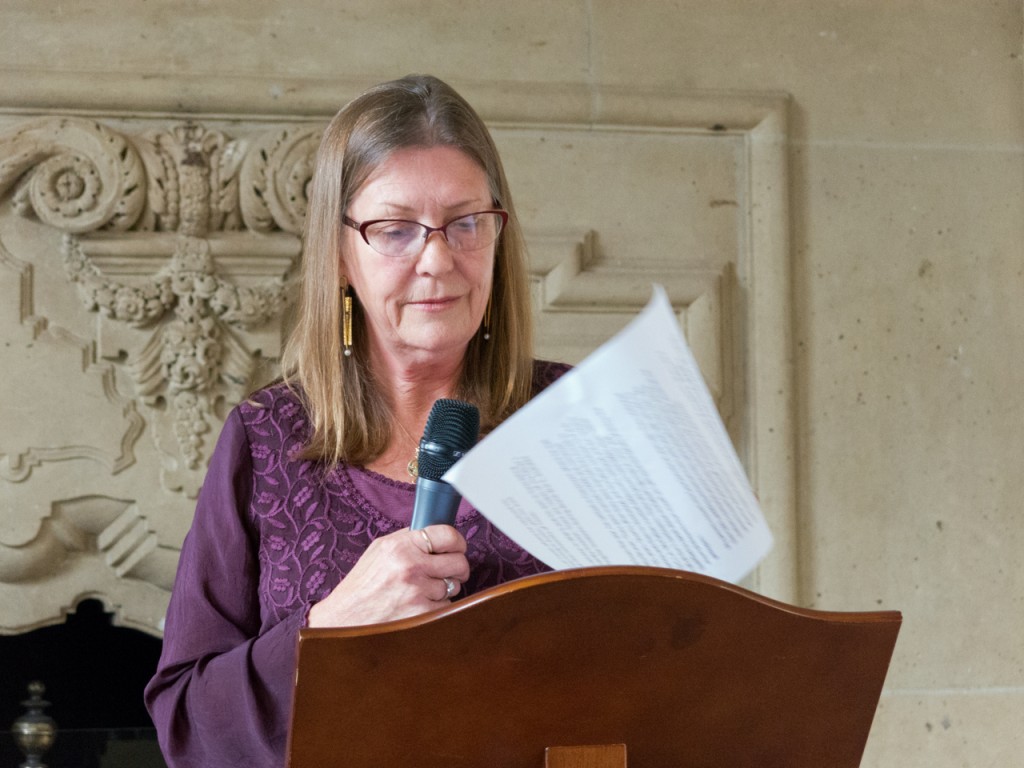
Marty Bobroskie, John Crowell’s daughter
Hello Everyone. I am Marty Bobroskie, John Crowell’s daughter and only child. I want to thank you all for coming to celebrate and honor my father’s remarkable life. Many of you have flown long distances to be here today and others of you know me from my frequent trips to visit my father here at Casa Dorinda. I was very close to my father and his passing is a great loss to me and our family.
I’m going to begin with some basic history of my father’s life, events that no doubt shaped his future and made him the man we grew to love and respect. My father was born in 1917 in Pennsylvania to James White Crowell and Helen Hunt Chambers. In the late 1920’s, John, with his parents and his younger sister Helen, traveled to Europe so his father could do research and complete his P.H.D in Romance Languages. During this time, John and his sister Helen spent time in boarding schools in France. Ultimately, John’s father became a professor of Romance languages at Pomona College in Claremont.
My father’s great uncle was Thomas Eakins, a famous American painter and photographer. My father’s grandmother, Francis Eakins was Thomas Eakins’ sister. Paintings depicting the Crowell Eakins family hang in the National Gallery in Washington D.C. and galleries throughout the world.
My father was an Eagle Scout and when he was just 14, he went on an expedition to Mexico with his father and a group of scientists. This sparked his interest in science and his love for Mexico and latin American culture, thus my choice of music for his memorial. My father went to the University of Texas where he received his Bachelors of Science degree while living in Austin, with his aunt Caroline Crowell, a physician at the University of Texas.
My father was proud of his service in WW ll and his part in forecasting the weather for the Normandy Invasion. There are copies of my father’s war book, Surf Forecasting for Invasions during World War ll, available after the memorial. After he returned from the war, he settled in Claremont where he met my mother Betty Bruner. They were married in 1946 and remained married for 61 years. Shortly after they were married they moved to Santa Monica and then to Westwood and my father received his P.H.D. from U.C.L.A. My father traveled extensively, lectured and did research on all of the 7 continents. There are people here today, much better qualified to speak about my father’s geological career and accomplishments than myself so I will leave the details of this to the geologists.
My parents moved into Casa Dorinda 24 years ago. They celebrated their 50th wedding anniversary here and 8 years ago, we held my mothers memorial service in this same beautiful music room. My parents loved Casa Dorinda, the friends they made here and the attentive and loving staff. On my every visit, my father would tell me how happy he was here at his home at Casa Dorinda.
I had a magical childhood thanks to both of my parents. When I was a young girl my father was the chairman of the U.C.L.A. geology department and our Westwood home was a revolving door for graduate students and international visitors. I was never surprised by what our foreign dinner guests might wear or bring as a gift and I was blessed with a multicultural upbringing.
On many summers my father would have lectures or field trips scheduled abroad and he would usually take both my mother and me with him on these trips. I have lived in chalets in Austria; in an adobe cottage at the edge of the Salton Sea, California; on a farm outside of Edinburgh; in a thatched cottage in Gillleje, Denmark and in a hotel-apartment in Bogota Columbia. I embraced and enjoyed the international travel that my father’s career required and provided. These trips exposed me to the art and culture and natural wonders of this world and greatly influenced my career as a jeweler and instilled my life long passion for travel.
Thanks to my remarkable parents I felt no limitations in what I might achieve in life or make my career. Although I suspect my father might have wished me to be more scientifically inclined, he supported my artistic talents and entrepreneurial spirit. With my mother an artist and my father a scientist, I had two remarkable role models to emulate. My father was a loving father, grandfather and great grandfather and the umbrella of security that he has provided has blessed us all with opportunities that otherwise might not have been available to us.
For the geologists in this gathering I will share this amusing story. The exact time and place may be incorrect but the story is as accurate as I can remember. I was in my mid teens and on one of many hiking trips with my father in the Painted Canyon area adjacent to the Salton Sea. My father was wearing hiking boots and shorts and carrying his iconic geological pick hammer. He left me to walk up the canyon on my own but assured me we would connect on his return trip back down the canyon floor. Like a Ninja, he sprinted ahead and climbed to the ridge top. I meandered slowly on my own when a small group of young women passed ahead of me. My parents had a family call when separated, somewhat like gibbons “whooping” for their troop. Some time later, my father returned jogging back down the canyon with his pick hammer swinging and “whooping” to apprise me of his location. I heard his familiar and welcoming call but the women ahead of me saw only a deranged man, whooping and jogging towards them with a pick hammer swinging.
Over the past eight years, since my mother’s passing, I have visited my father frequently and grown even closer to him. Casa Dorinda has been a welcoming second home. Not only will I miss my father every day for the rest of my life, but I will miss the friends I have made here at Casa Dorinda.
A week before my father’s actual birthday, our immediate family came to celebrate his 98th birthday. We enjoyed two days together including a trip to the Santa Barbara Zoo. My father was articulate and in great spirits.
Late morning on his 98th birthday, we received a call from the medical center. My father was having chest pains and not feeling well. When Art and I arrived late afternoon, my father was unconscious. I was at his bedside when he passed early the following morning.
My father achieved many milestones in his life and we half expected him to reach his 100th birthday. Pragmatically, he would often say that none of us get out of this life alive and that he hoped to just wake up dead one morning. He lived a remarkable and fulfilled life and passed in the manner that he hoped.
Below – Memories of Cliff Hopson – Friend and Colleague. Earth Science Department U.C.S.B.
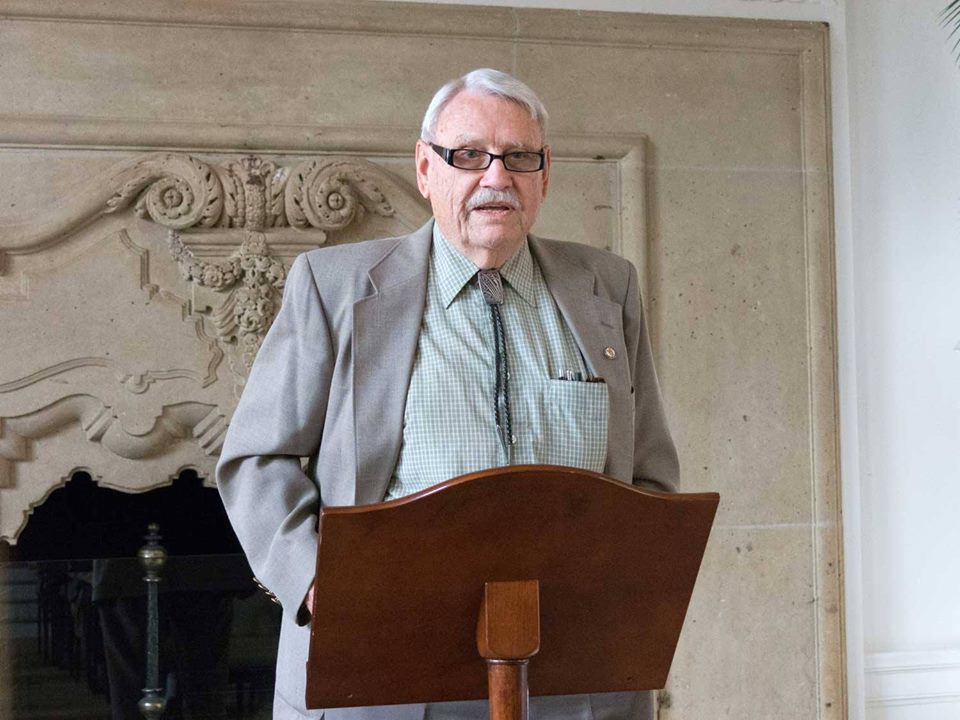
Cliff Hopson, John Crowell’s Colleague and Friend
We’re here to say goodbye to John Crowell, but it will be a long time before he’s forgotten. Certainly not by those of us here. I’m here is to say a few words about John’s time at UCSB, and about the great impact he made. He came to our campus about halfway through his professional career. The first 20 years were at UCLA, where he rose to distinguished professor status and twice served as department chairman. He had already established a huge reputation for his work on the San Andreas and San Gabriel faults, and related tectonic sedimentation.
Most of you know of John’s many scientific accomplishments and the important honors he won. So I will talk instead about how he came to UCSB, and the importance of his presence here for the growth of our department.
The Geology Dept here was already well established during the 1950’s, staffed by Bob Webb, Bob Norris, Dick Fisher, and Bill Wise, among others. But the mission of this campus changed after ~1960, when UCSB was slated to become a major campus of the University of California, with a strong research component and doctoral programs in the major departments. In Geology, Aaron Waters was brought out from Johns Hopkins Univ. to head the department, to develop an active doctoral program, and recruit new research-oriented faculty and promising graduate students. He arrived here in 1963 and had a PhD program up and running by the next year. Hopson and George Tilton came here in 1964 and 65 and other additions were planned.
And then came this amazing telephone call from UCLA! It was John Crowell , wanting to explore the possibility of transferring to UCSB. It was astounding that someone of his stature would approach us! He was immediately invited for a visit, and Waters and I took him to lunch and a powwow at the El Encanto terrace on the Riviera, with its superb view of Santa Barbara and the harbor. John’s reasons for wanting to transfer were straight forward: after two terms of chairing the large and distinguished but contentious department at UCLA, with pressure to take on a third stint, he had a belly-full of administrating. Also, he had embarked on a new research project in the southern hemisphere that demanded full attention. He wanted to get away from the hassle at UCLA, and big-city dwelling, to concentrate on research and graduate teaching while living in attactive surroundings. He knew our plans for department growth and was encouraged by the dept’s potential.
The next step in the negotiations was pure John Crowell: He proposed leading a 2-day field trip to Ridge Basin and adjacent San Andreas fault, to be attended by the Santa Barbara geology faculty and grad students and by his UCLA students, so we could get a better look at each other. It was a stimulating and successful field trip, and the following year John and Betty Crowell moved to Santa Barbara.
This proved to be a happy arrangement, both for John and especially for our Geology Dept. John fruitfully pursued his southern hemisphere project, expanding his late Paleozoic glaciation studies in southern South America and South Africa to southern Australia, India, and Antarctica, thereby helping to establish the former existence of the Gondwana supercontinent and its subsequent breakup. This work, along with his earlier studies of large-scale faults in southern California and related tectonic sedimentation, led to his election to the National Academy of Sciences and other important honors.
The Geology Dept., now renamed Geological Sciences, benefitted immensely from John’s presence. While never a dept. chairman here – by his own request – he was soon directly responsible for two important new faculty appointments. Arthur Sylvester was hired following John’s strong recommendation; he later succeeded John as our structural geologist and won important honors of his own. And then came this second amazing phone call from UCLA! It was from John’s former colleague Prof. Preston Cloud, internationally famous geologist and paleontologist known esp. for his work on pre-Phanerozoic organisms and the early earth’s surface evolution. He too was interested in transferring to UCSB. Pres’s reasons were different, but John Crowell’s presence here was clearly a very strong drawing attraction. The two men had much in common professionally, and several years later they jointly conceived the idea, and then were instrumental in founding, the Environmental Studies Program at UCSB.
By this time the presence of Crowell, Cloud, and Tilton – all Natl. Acad. Sci. members – plus an able supporting cast – gave the department a luster that helped it to attract still other highly productive scientists to our faculty. I think especially of Tanya Atwater, who teamed with John, later joined by Bruce Luyendyk and Craig Nicolsen, to put the San Andreas and related faults into a plate tectonic context. In short, John Crowell’s presence on our faculty increased the dept’s stature and was a big factor in its rise to distinction.
John Crowell also acted like a magnet to attract promising graduate students who went on to outstanding geological careers. Nicolas Christie-Blick and Julia Miller, who have already spoken to you today, are two of these.
John’s highly creative research with his graduate students resulted in an imposing bibliography, culminating in his GSA Memoir on ancient continental glaciations. The body of his work won him highly prestigious honors, including election to the Natl Acad of Sciences and then the Penrose Medal, the highest honor bestowed by the Geol. Soc. of America.
John taught structural geology, field studies in tectonics, and graduate seminars in structure and tectonics. In his teaching he was at the absolute top of his game in the field. More than anyone I know he had the unique ability to relate field features seen in outcrop to the regional tectonic picture. Being in the field with him was a great learning experience and a marvelous adventure. And a lot of fun.
John’s research and publications continued long after retirement. His interest in solving important tectonic problems continued even into his last few years here at Casa Dorinda, while in his 90’s. I took him twice on field excursions after he could no longer drive, thinking he would like to tour areas of his former research, such as Ridge Basin. But he was’nt interested in merely looking at the scenes of past glories. Rather, he wanted to explore new unsolved problems, one being the Cenozoic tectonic history of the crystalline basement of the Liebre Mtn tectonic block. He never lost the drive that characterized his active years.
Much more could be said but its time to end. I think I speak for all his colleagues in saying that knowing and working with John has been an inspiration and one of the highlights of our geological lives.
Below, Memories of Nicholas Christie Blick – Former PHD student of John Crowell and a “Crowell Troll.”
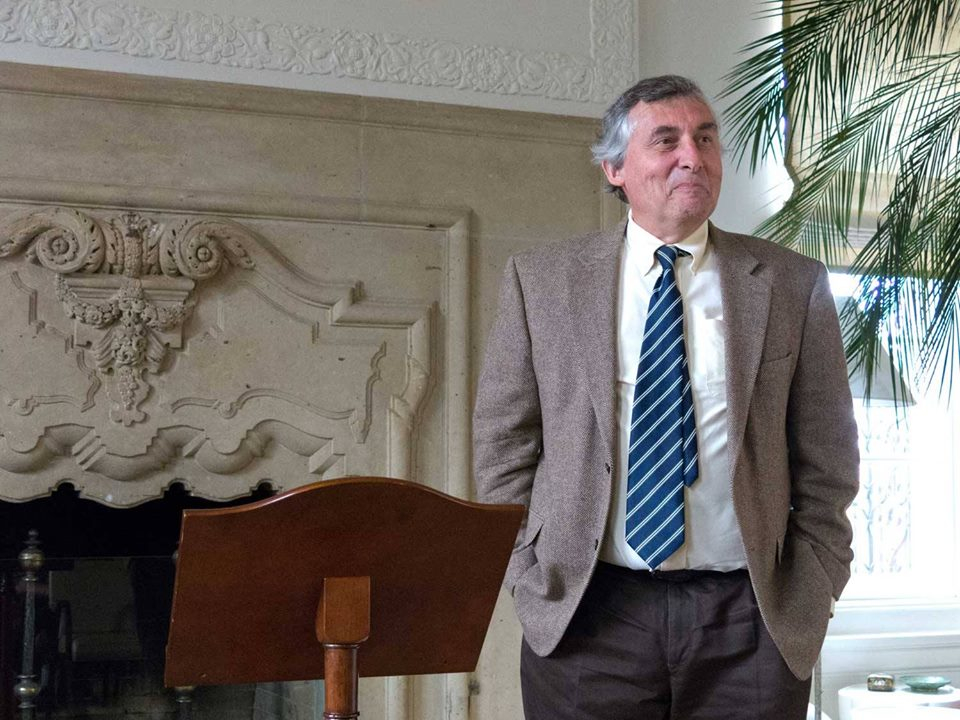
Nicholas Cristie Blick – Earth Science Dept. Columbia University.
By design, no written version exists. After protracted mulling, I sat on a bench at the Santa Barbara Mission for 10 minutes on Saturday morning, and jotted down a list of topics.
Scientist: Why, perhaps surprisingly, I view JCC’s work on southern California tectonics as more influential than his research in ancient glaciations. Evidence for large lateral offset along the San Andreas fault was a surprise in the days before plate tectonics. JCC’s PhD dissertation documenting the relation between deformation and sedimentation in Ridge basin was completed more than 30 years before sediments became generally appreciated as a record of crustal deformation. I continue to use his 2003 review paper as an assigned reading in my Sedimentary Geology course.
Teacher: I acted as TA for JCC’s Structural Geology course twice. Among fieldtrip stops in that course: a cross-sectional view of a large fold in the Ventura basin that he would invite students to sketch. The idea was to engage the students in recognizing important attributes of the structure. I have employed the same approach with first- and second-year undergraduates in my annual Death Valley field excursion. The students very much appreciate the opportunity to develop interpretations on the basis of observations that they themselves make.
Mentor: JCC was my #1 choice advisor, based upon the recommendation of Brian Harland in Cambridge. Harland was aware of JCC’s research in Paleozoic glaciation, and had himself published extensively on Proterozoic glaciation, the topic I wished to pursue. I talked about meeting JCC and Betty for the first time in the summer of 1974, and spending several days examining Proterozoic glacial deposits in western Scotland (Islay and the Garvellachs).
I was among the last of JCC’s PhD students. Paul Link and Julia Miller, with whom I overlapped, completed dissertations in 1981 and 1983, respectively. Thom Davis and Derek Rust, also at UCSB in those years, worked on southern California neotectonics (active faulting). Dick Tosdal and Dan May worked on crystalline geology sliced up by the San Andreas fault system. Emery Goodman (JCC’s final student) reconstructed the evolution of the southern San Joaquin Valley.
JCC, the effective grant getter, who impressively dictated his proposals into a tape-recorder – to be typed by his secretary. The only person whose telephone calls he would take when consulting with students was John Lance, his program director at the National Science Foundation in those days.
I talked about JCC as field trip leader in the days before fancy tools and graphics. The maps pasted onto a cloth background to allow them to be folded without damage. The way in which JCC would use his hands to help describe relationships (including the now famous signal for right-slip faulting).
Finally, I mentioned JCC’s continued interest in the years after graduation. The opportunities that would mysteriously arise. The 30-minute chats at GSA meetings. My most recent trip to Santa Barbara was a west coast campus visit with my son (Winston) and wife (Kottie) in 2004. We had a very nice dinner with John and Betty at Casa Dorinda.
Below – Julia Miller speaks of her memories of John Crowell and being one of his three “Crowell Troll’s.”
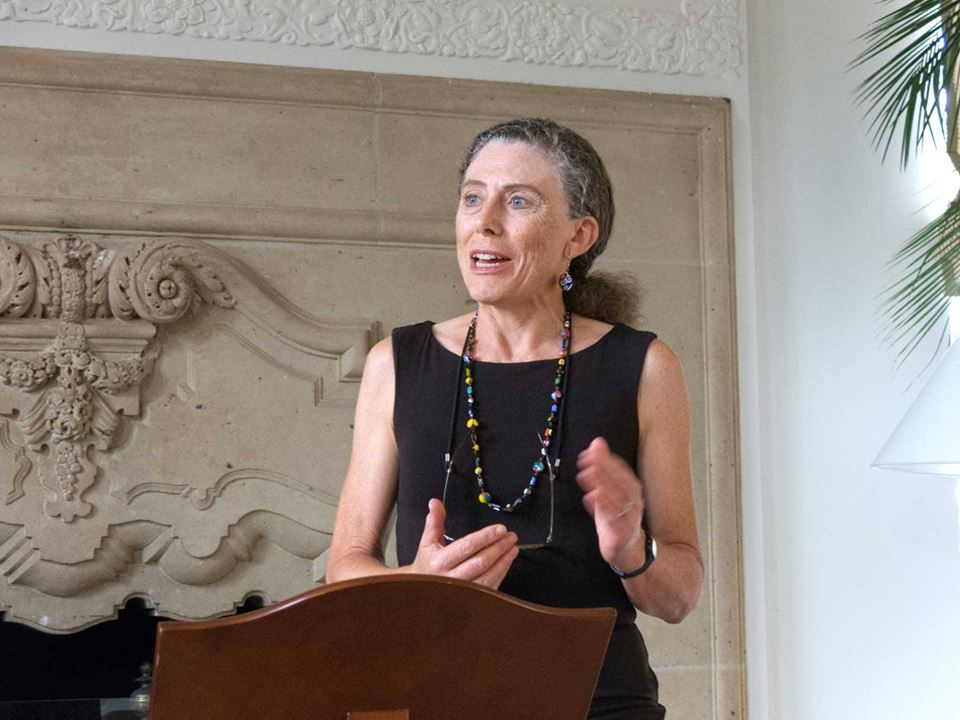
Julia Miller, former PHD student – Dept of Geology, Vanderbilt University, Nashville, TN
This is an attempt to outline the short presentation I gave (for which I had an outline and brief notes, but never wrote a full script) Julia M.G. Miller
1. My connection to JCC – I was a graduate student of his; he was my advisor, mentor.
I was one of the three ‘Crowell’s Trolls’: Nick, myself and Paul Link, now at Idaho State Univ. Paul is teaching field camp and so could not be here. Explanation of ‘Crowell’s Trolls’ – term coined for us (we think by Paul) when we helped JCC and Max Crittenden run an international (International Geological Correlation Program) field trip looking at Proterozoic glacial deposits in the western U.S. in October 1978.
JCC recruited me from England, v. significant for me because connected with me moving to CA to be close to the man who is now my husband. (When did JCC realize this connection? He & Betty attended our wedding.)
JCC later admitted to having had some concerns about an English ‘girl’ working in the CA desert (Death Valley area). He liked to tease me about the expression on my face when I first saw the desert as I woke on my first morning in S.Death Valley. (We had driven out from UCSB the night before in the dark.)
2. I find myself filled with gratitude for all that JCC gave me.
He gave me excellent geological training and wonderful professional mentorship. I really don’t think I appreciated the fantastic geological situation that I fell into, working with him. I was frequently learning and surprised to discover work that he had done, of which I had been unaware. And, he offered me abundant professional opportunities, such as participation in the international field trip when we were dubbed ‘Crowell’s Trolls’!
John also showed real personal care and concern for me, concerned as to my well-being and that of my family. As mentioned above, he and Betty came to my wedding and always expressed interest and concern for Paul, yet was respectful of me, my space, my choices, my life.
I particularly remember how he cared for me and supported me when I was sick during a field trip in rural Brazil. I was miserable, being sick in a foreign country is miserable, and I was very touched by the concern he showed and how he ensured that I received what I needed.
3. JCC was a very supportive and wise mentor. He supported and encouraged me, and us graduate students, in doing our work. He gave us a lot of independence , did not interfere much. He believed in me, believed in my success; he seemed to have no doubt that 1/we would succeed and allowed us to succeed.
Quoted Paul Link’s words about his experience as a student of JCC:
“”What I remember most about JC was his ever-supportive mentorship. Some graduate students compete with their professor, trying to be as good. With John there was never any doubt that you would succeed, and that he would support you. This is perhaps the most valuable lesson a professor can impart, and I hope I have used it in advising my own graduate students. I cannot imagine a better advisor for a graduate student than John Crowell.” Extracted, with permission, from an E-mail sent by Paul Link.
I echo these comments of Paul’s.
I found JCC to be accessible when I needed him, but not too accessible. Also, when I did have time with him I usually had questions and/or was seeking advice. My recollection is that he would typically turn my questions back over to me, so making, or encouraging, me to make my own decisions. At the time I found this rather unsatisfactory. I wanted his opinions. In retrospect, I can see that he was wise to encourage me to decide for myself. He was fostering my independence.
4. JCC was generous – always looking out for the best for me, for his students, and for opportunities, professional opportunities, for us. I always appreciated that he never made any suggestion that he would share in the authorship of our work, as many (or most) advisors do. Our work was our own. We published our own single-author papers, unless he actually made some tangible contribution himself.
Impressed by how organized he was: his handwriting neat and legible, his notes, books so well-organized. Also foresightful: I remember we persuaded him to give us a talk and slide show of his time in Antarctica. He had recollections and careful photos showing logistical details, e.g., the food they ate, in addition to the geological information. This would have been 15-20 years after he had been there.
For the most part, he was always calm and in control of things. Only once can I remember finding him flustered, stressed: he was working with his secretary to complete a grant application, no doubt for an imminent deadline, and I can remember picking up the tense atmosphere and knowing to keep out of the way!
6. He was formal. We called him J.C., never ‘John’. Even though we graduate students referred to other faculty in the department by their first names, Art, Jim, Cliff etc., J.C. was J.C..
I only began to call him ‘John’ after I had graduated and left UCSB. I made a concerted effort because I thought it appropriate at that stage to call him John!
In conclusion, I find myself filled with enormous gratitude to have known and had the opportunity to work closely with such a remarkable man, someone so very accomplished in our field, and someone who guided and advised me in such very wise and caring ways. Thank you for sharing him with me, for all that your father gave me.
From: Julia M.G. Miller
– originally delivered orally, from outline and short notes, 6/27/15
– written down, trying to reproduce what I said as best I could, 7/18/15
Hello, my name is Julia Miller. I was a graduate student of John Crowell’s. I was one of the three ‘Crowell’s trolls’ working on ancient glacial deposits in the western U.S.. Nick, who you already heard from, was one, I was another, and Paul Link, who is now at Idaho State University and could not be here because he is currently teaching field camp, was the third. The circumstances through which I came to work with John were very significant to me, and perhaps to him. As I expect you can tell, I am English. I was looking for an opportunity to do graduate work in geology in California at the same time that John was looking for a student to work on Late Proterozoic possible glacial deposits in the Death Valley area. I wanted to be in California as soon as I could be, because I wanted to be near a man I had met (actually in West Africa), who is now my husband. So when I ended up corresponding with John and he accepted me, at fairly short notice, for a research assistant position on a grant which was already funded, I was elated. It all worked so well together: I could do graduate work in California, which I knew was a wonderful place to do geology, and I could be near the man who became my husband. I’m not sure when John put all this together, i.e., how significantly he assisted me in my personal/romantic life as well as in my professional life, but I think he must have realized it at some point. John and Betty came to Paul’s and my wedding, which took place about 9 months after I had arrived in the U.S.
Below, Memories of Emery Goodman – former PhD student of John Crowell’s at U.C.S.B.
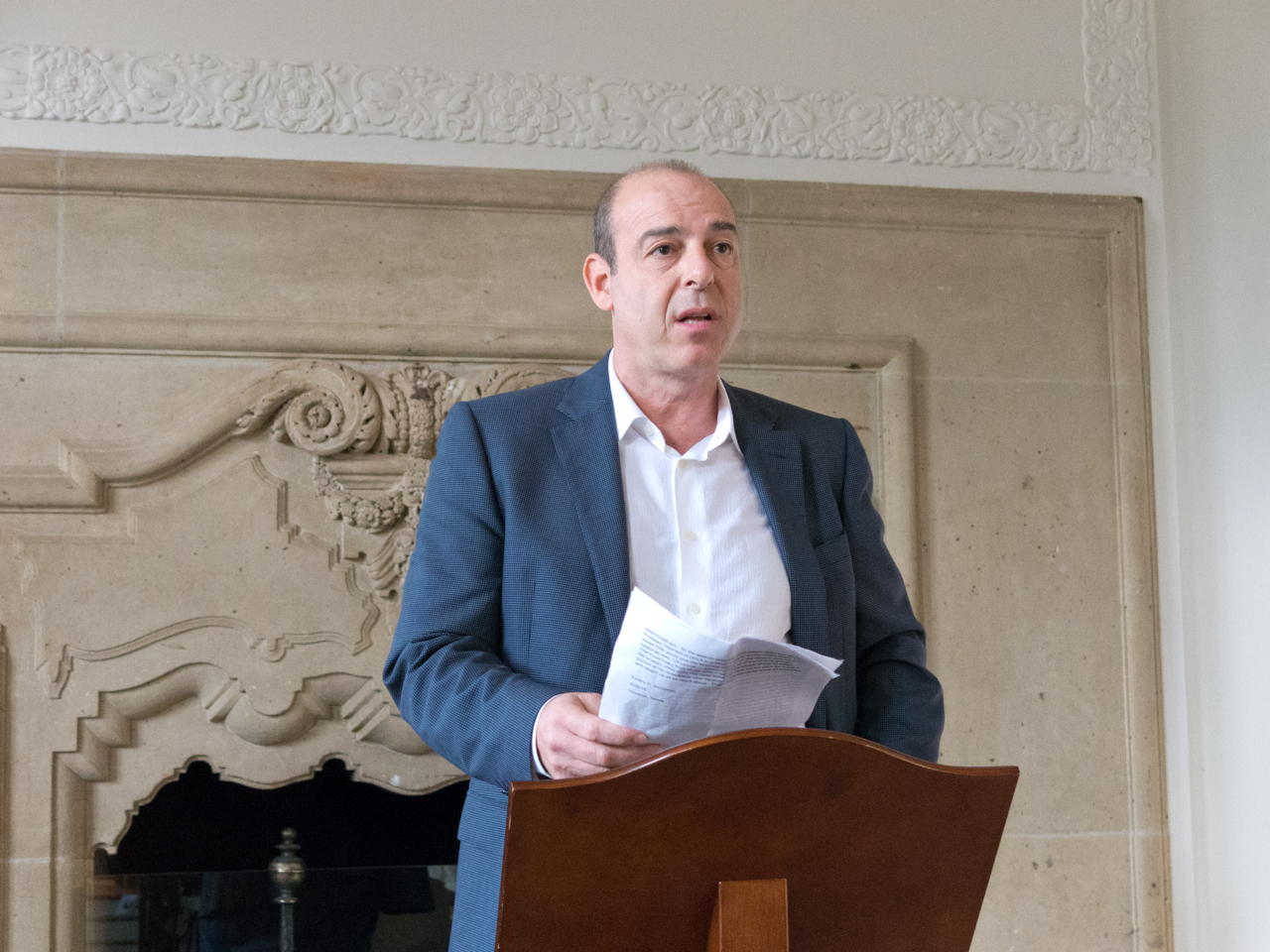
Emery Goodman – Former PHD student, Geologist – Exxon Mobil
Good Afternoon. My name is Emery Goodman and I’m very honored to have an opportunity to say a few words honoring John and celebrating the near century of his remarkable life on Earth. I was a Ph. D. student at UCSB in the late 1980’s and was fortunate enough to work on a project with Prof. Peter Malin, now Director of Earth Science at the University of Auckland, and John, who together served as Co-Advisors on my dissertation, and to learn from them and many other distinguished faculty and fellow students. I owe John a huge debt of gratitude along with warm affection and profound respect.
There are so many things one can say about John’s scientific achievements along so many fronts. His legacy in that regard is well known by this audience and can be better summarized by others. So, I want to limit my remarks and anecdotes to how John impacted my life and career and his unique blend of characteristics and his humanity that made him so unforgettable. I was just one of hundreds of students that John mentored through their graduate work and he displayed tremendous care and concern for so many of us. In my case, I had debated leaving a good job in the energy industry to come to UCSB to work on my doctorate, with an uncertain funding situation not to be resolved anytime soon, and so we had a lively snail mail correspondence as I made what, for me at the time, was a tough decision for me and my family. His patience, care and understanding of my situation was remarkable for such a busy guy who had no shortage of students looking to work with him. I remember his exact words, “I feel for you for you on these difficult choices”. Well I resigned, came to UCSB, benefited from John’s guidance and mentoring and never looked back. To my knowledge, I ended up being the Professor’s last Ph D student and can only imagine that it was reading through my heavy tome that finally had him say “no mas”. Fast forward to just a few years ago when I was going through tough time both personally and professionally. I let John know this is as part of a letter I wrote to him and though it clearly was physically painful for him to write out a hand written note of just half a page, he expressed his sadness and best wishes that things would get better. He offered no platitudes or easy fixes. Things eventually got much better.
Several years ago, I had an opportunity to say a few words at the year-end Geology Department gathering here in Santa Barbara. The gist of my thankful comments was, that beyond all the great science I learned about from the UCSB faculty, I also learned a lot about leadership, a subject best taught by actions not words. John, with his natural abilities and military service, had so many great traits in this regard – he could create a compelling vision, saw what was possible, had passion and enthusiasm, brought out the very best in others, ethics and integrity beyond question, you could trust him to provide honest feedback, however painful it may have seemed, and he truly respected different perspectives and opposing points of view.
On the latter point, John’s tectonics seminars held one evening a week at his home, were a real highlight. We students would be warmly greeted at the door by John or Betty, the smell from one of Betty’s wonderful, homemade desserts filling the air. John actively solicited students outside the tectonics crowd to take these seminars and cleverly drew them out in our discussions. Other faculty would also attend these seminars and we graduate students were expected to present the essence of a paper, as John would say “without the benefit of notes”. So, I feel a little guilty up here today with my notes. Anyway, the collective grilling could be pretty tough, but he was preparing us for the real world and was also seeking honest and broad dialog. John often said that Geology is a social science and real progress only came with active collaboration and integration.
John’s guidance could be even more subtle: John’s military experience leading convoys through Asia in WWII naturally morphed into leading graduate students in Carry-All vans into the California desert. On one such trip I had the honor of driving the lead vehicle with John sitting next to me and periodically communicating with the other 5 vehicles. John was famous for getting on the radio and, in his commanding voice, providing instructions and commentary, like “Now hear this!! On your right is the San Andreas Fault”, etc. As we were pulling out of Santa Barbara, not too far from here, one of my colleagues from the rear vehicle got on the radio and said “I don’t know if anyone is interested but a California Highway Patrol car is coming up behind us and we’re going pretty fast…”. I was driving at 70 mph + no doubt. John never looked at me or said a word, he simply picked up the radio and said “Now hear this! We will NOT exceed the speed limit, let me repeat, we will NOT exceed the speed limit”. I of course slowed down.
As I was leaving UCSB and heading to work in Esso’s research labs, I learned that my initial assignment was going to be pulling together the regional tectonics of SW Asia, a complicated place indeed, along with an all-star cast of world-class experts. I expressed a bit of trepidation to Peter and his response was, “Remember that you have an advantage none of the others have, you’ve worked with John Crowell”. I wasn’t quite exactly sure what he meant at the time but he was so right. So many times, especially early in my career when faced with a tough technical problem I would ask myself how John would approach it and what were the key questions he would ask. He was the ‘Sempai’ that sat on my shoulder.
John maintained a very youthful enthusiasm for knowledge and making new discoveries for the 30 years that I knew him. Years ago, during one my all too rare trips back here, John walked with me down to my car which was parked along Goleta Beach. A large Pacific storm had occurred a few days earlier and some unique sedimentary deposits related to that storm were preserved at the back end of the beach. John wanted to show me and I was keen to see it. A problem emerged: the specific “outcrop” that John wanted to show me was no more than a foot away from the head of a bikini-clad sun worshipper. What to do? No problem, John introduced himself to the young lady, stated his position at the University and said good naturedly, “I hope you won’t mind if my friend and I do a little geology here?” What could she say? I never let my great admiration of Professor Crowell get in the way of having fun with him. And we had some good laughs.
Early last year, Jill and I spent a delightful afternoon here at Casa Dorinda with John. I had the honor of pushing and he gave us a thorough tour of buildings and grounds and treated us to a great barbecue lunch. Everywhere we went John was greeted with a respectful, “Hello Professor!”. He clearly loved this place, was in turn loved back, and it was comforting to me to see all of this. However, as we walked back to our car, it occurred to me that it would be the last time I would see John and that saddened me a great deal.
In closing, several years ago, the AAPG organization asked me to help them put together a special session honoring John’s career contributions in the field of tectonics and sedimentation. It was not something John sought and his initial comment to me was no thanks, that he had been honored enough. With the annual meeting being in California that year, an unusual occurrence, the AAPG was determined to make this happen and I’m a pretty determined guy. So the session planning went ahead. After first asking Professor Ingersoll of UCLA to present a paper on the Ridge Basin, I then asked if he would give the technical keynote for the session and his email response was: “Of course, John Crowell: one of the all-time greats”. That’s just how I think about John — one of the greats of that Greatest Generation. How lucky I’ve been indeed to have known John for a just a portion of his remarkable near-century on the planet he knew so intimately and taught us all so much about. Thank you.
Arthur Sylvestre, U.C.S.B. Earth Science Department. Arthur was instrumental in writing the geological part of my father’s obituary.
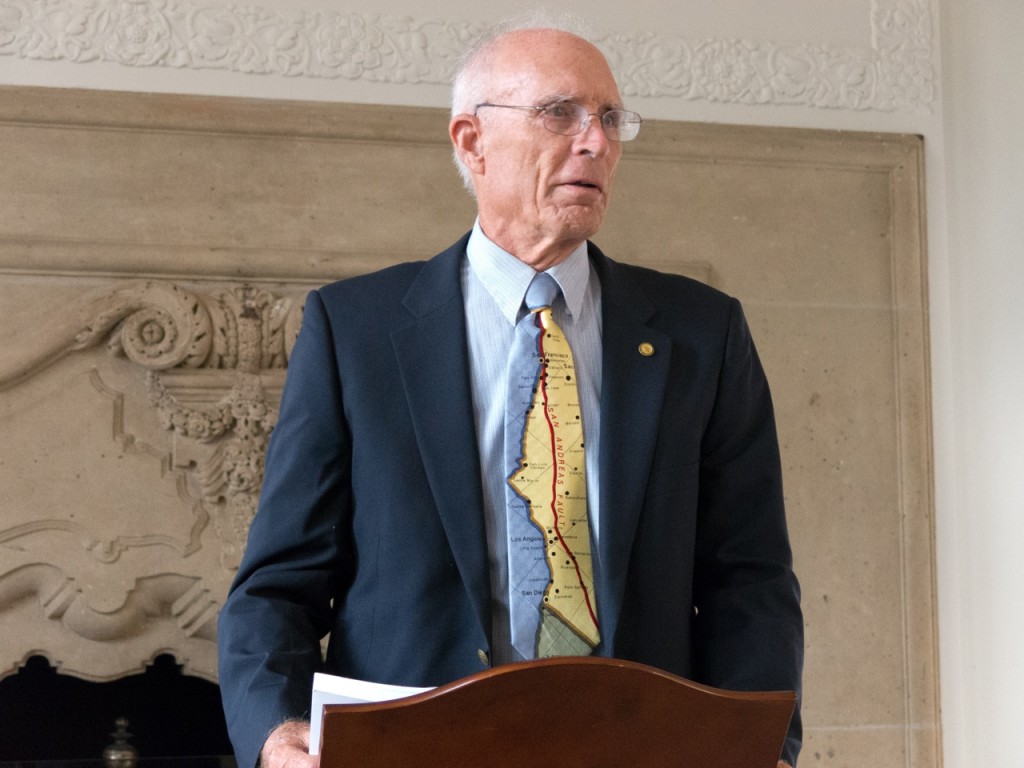
Arthur Sylvestre – Friend and Colleague, Earth Science Dept. U.C.S.B.
John Chambers Crowell, 1917-2015
John Crowell passed away May 13, 2015, on his 98th birthday. He was world-renowned university professor and geologist who spent most of his professional career on the faculty of the University of California, first 20 years at UCLA, and then 21 at UC Santa Barbara. By his own admission and calculations, his was a full life of adventure, discovery, and honors.
Crowell was born in State College, Pennsylvania, to James and Helen Crowell in 1917. A succession of moves took the family eventually to Claremont, California, where John’s father took a position as professor of Romance Languages, where John gained his interests in science and the outdoors, and where he met his life-long companion, artist Betty, with whom he spent many joyful years.
After graduating from the University of Texas with a degree in geology in 1939, Crowell undertook graduate work at UCLA. While studying the geology of a part of the San Joaquin Valley, he was offered employment as a geologist with Shell Oil Company and would have followed that career path had not World War II military service serendipitously intervened. The U.S. Army put him into intensive training as an oceanographic meteorologist with several of the world’s leading meteorologists and oceanographers, and as a consequence, he was a member of General Dwight D. Eisenhower’s Operation Overload weather forecasting team that made the critical forecasts of sea, swell, and surf for the June 6, 1944, Normandy Invasion. With that background, Crowell obtained his MA in oceanographic meteorology from Scripps Institution of Oceanography in 1946 and then his PhD in geology from UCLA in 1947, where he was a distinguished university professor for 20 years.
Crowell came to UCSB from UCLA in 1967. With Professor Preston Cloud, he founded the UCSB Environmental Studies Program. He taught courses in structural geology, field studies in tectonics, and graduate seminars in structure and tectonics, not only at UCSB, but also in short courses all over the world for the American Association of Petroleum Geologists’ Continuing Education Program, and for many oil companies and geological societies. His graduate students literally roamed the mountains and deserts throughout the world, and Crowell, always right alongside them, said that they taught him about the world.
Crowell’s research contributions are primarily concerned with sedimentation, tectonics, paleoclimatology, and the regional geology of California. In the early and mid 1950s he published several papers dealing with the origin of submarine canyons and turbidity currents. In California and the Alps he studied the characteristics of flysch-type sedimentation. During the 1950s and 1960s Crowell worked out the displacement history of some of the major strike-slip faults in California, including the San Gabriel and southern stretch of the San Andreas.
Crowell’s work of the tectonic and sedimentation history along the San Andreas transform belt formed the basis for his seminal publication about the nature of these processes along similar tectonic belts, such as those in the Caribbean region, southeast Asia, Australia, the North Sea region, and the Alps. His interest in downslope sliding processes, in California as well as in Europe, led him to study the origin of pebbly mudstone and to discriminate between these downslope deposits and those laid down by continental glaciers. In the late 1960s this interest led Crowell to investigate the record of ancient glaciations in Europe, North American, and especially on all of the Gondwanan continents in the Southern Hemisphere to work out the history and causes of continental glaciation through geologic time.
Among Crowell’s many honors, those he cherished most are membership in the US National Academy of Sciences, fellowship in the American Academy of Arts and Sciences, the Penrose Medal and the Career Contribution Award from the Geological Society of America, and an honorary doctorate from the University Louvain, Belgium.
Crowell retired from active teaching and research in 1987.
Below, Bob Flink, a friend and Casa Dorinda Resident speaks and shares memories on behalf of John Crowell’s friends at Casa; John’s home for nearly 25 years.
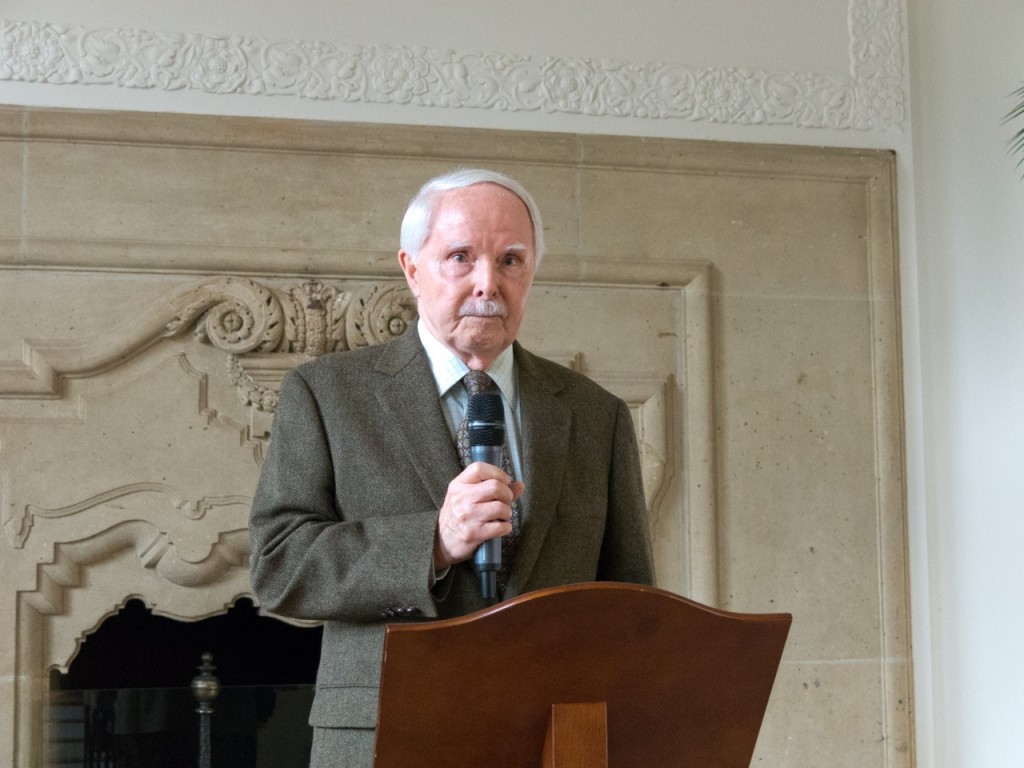
Bob Flink – Friend and Resident Casa Dorinda
Below, The thoughts and words of Robert D. Butler, Jr., RN, 27 June 2015.
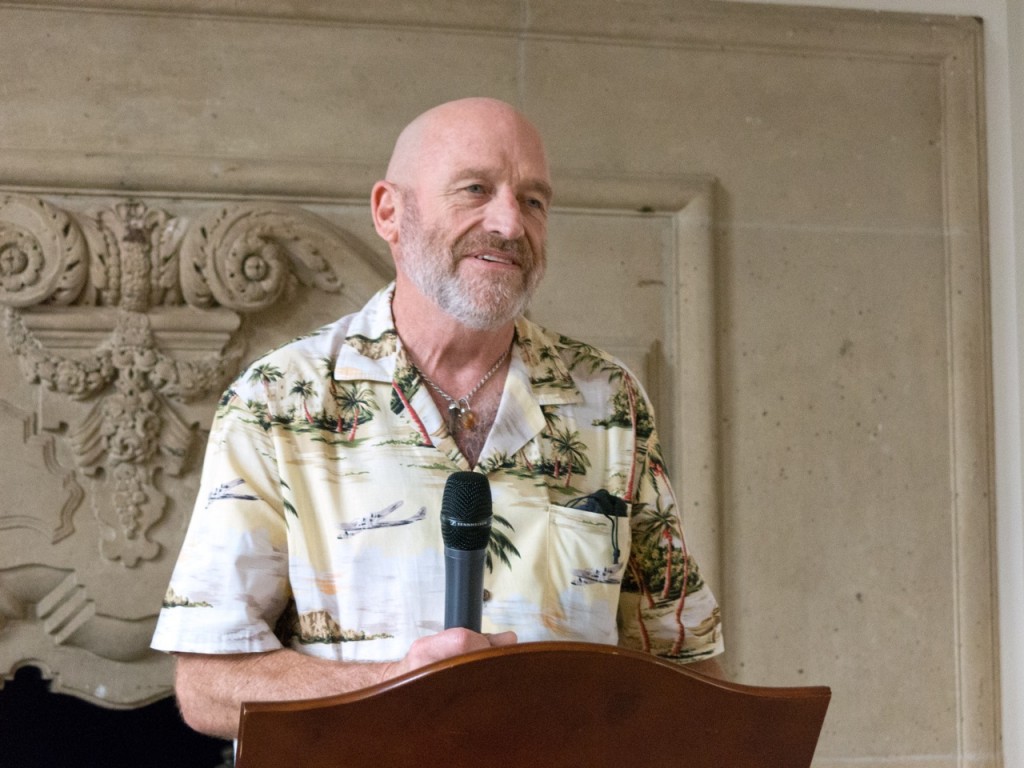
Rob Butler – RN and Friend
My dear friend, “the Professor,” finally left us, to join his beloved Betty, at the dawn of his 99th year. I was reminded, last night, that he told the CNAs working with him, in the early hours of May 12th, that this was the day he was going to die.
Professor would say to me that I was the only one “who did not get tongue-tied when we spoke.” Who knows, perhaps that is because I grew up so close to the San Andreas Fault, in Palo Alto; or, perhaps, it was for something more spiritual…that is not for me to understand.
I was personally honored by him, in so many ways, during the time he was with us at the Medical Center. Those who knew him would not be surprised by this…at times he would say to me, “Rob, I would like to ask your opinion about some things.” (He was very formal, you know.) He asked my advice about so many things as we worked together. He asked questions about his health, about where to put things in his room, about why he was having so much difficulty, over those last few months; he valued my words, and, thoughts – a most wonderful recognition of our professional friendship. One night, after I had applied the pain-relieving gel to that ever-uncomfortable left shoulder, and had made sure his favored serapes were in place, covering him, he asked, “What’s wrong with me? Why am I having these problems?” I placed my hand on his, and said, “Professor, your heart is just not working as well, now.” I reminded him that Dr. Fearer, had been working very hard, with us, to help him with his comfort. I did not tell him to not worry, because that would have been disingenuous. He never sought platitudes; he was, after all, a scientist. He focused on realities.
Although, if I ever asked him a question, his answer generally came in some sort of non-committal way – such as, “perhaps”, “maybe”, “possibly”, or, “that could be,” I always sensed he sought something factual and definitive from me.
Once, he asked me, “Why am I still here,” in reference to his age. My response was, “because, Sir, your work is not yet done.” One night, as I finished treating his shoulder and tucking him in to bed, he looked up at me and said, “Rob, you’d make somebody a good wife.” As we laughed, and, he added the qualifier, “not in any perverted way,” I responded that I certainly did not have any question about his statement. I only saw it as a very high compliment. He asked if I had ever known Betty; unfortunately, I did not. I believe there was a partnership that was supportive, strong and committed.
As I listened to our President sing some of the words from “Amazing Grace,”(by John Newton) at the memorial service, in Charleston, Friday, a day on which some very important events occurred, I thought of the Professor…”Amazing Grace, how sweet the sound, That saved a wretch like me…I once was lost but now am found, Was blind, but now, I see.” Professor Crowell was a loving, caring man, who possessed “Grace.” He did not like to impose on others, to inconvenience anyone. He was always grateful for the care he allowed all of us to provide, at the Casa Dorinda community, and in the Medical Center.
We miss you and are grateful for the Grace you bestowed on us all.
The Medical Center became his home and we all did our best to help him be comfortable there. Once, I had to send him to Cottage, for some help we could not provide. A couple of days into his hospitalization, I took him his glasses, hearing aids and a book he was reading. At the request of his primary nurse, I placed the hearing aids into his ears, as he slept. He awakened, to say to me, “I just want to go home.”
Over the last year, “Professor” spoke with us about a dream he had to rent a boat and go out on the Sea of Cortez. “I could sit there and ask someone to get me a cold one.” Marty and I discussed this, knowing this was a wonderful dream but probably something very difficult to accomplish…His last Sunday, Mother’s Day, I was working with him. I walked into the room; and, although he was thinking about how soon he could go to bed, I asked if he had spoken with Marty, that day. As the answer was, “No,” I suggested that we call her, dialed her home number, and she answered. After wishing her a Happy Mother’s Day, I handed the phone to the Professor. None of us knew that would be the last verbal exchange between Father and Daughter. How wonderful that opportunity became. We will never forget.
Rest well, dear friend. Enjoy the bliss that you have earned and deserve. Now, Professor, you are home, with your devoted life partner and wife, Betty.
Art Bobroskie, John Crowell’s son in law, talks about John’s involvement in World War Two and his significant contribution in Surf Casting for the Normandy Invasion.
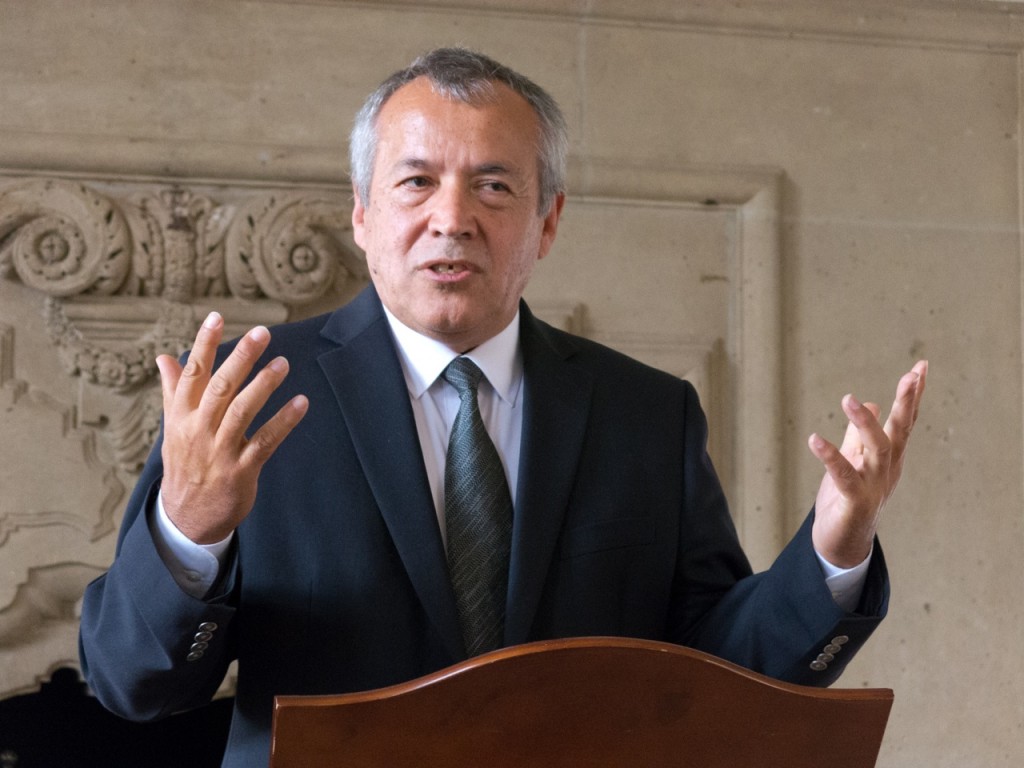
Art Bobroskie – Son in Law
Others stood to speak about my father, his contribution to science and his impact on their lives.
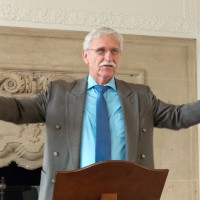
Ed Keller – Professor of Geology U.C.S.B.
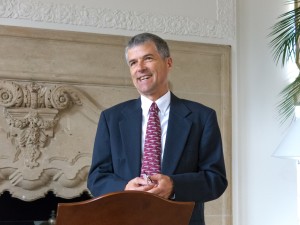
Andy Wyss – Earth Science Dept. Head. U.C.S.B.
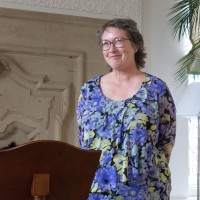
Kathleen Riedel, County of Ventura Geologist.
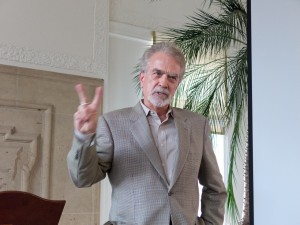
Bruce Luyendyk, Professor of Geology. U.C.S.B.
At the close of the memorial, one of the geologists mimicked my father’s familiar hand motions in describing slip faults to his students. The memorial ended with a Slip Slide Salute to John C. Crowell.
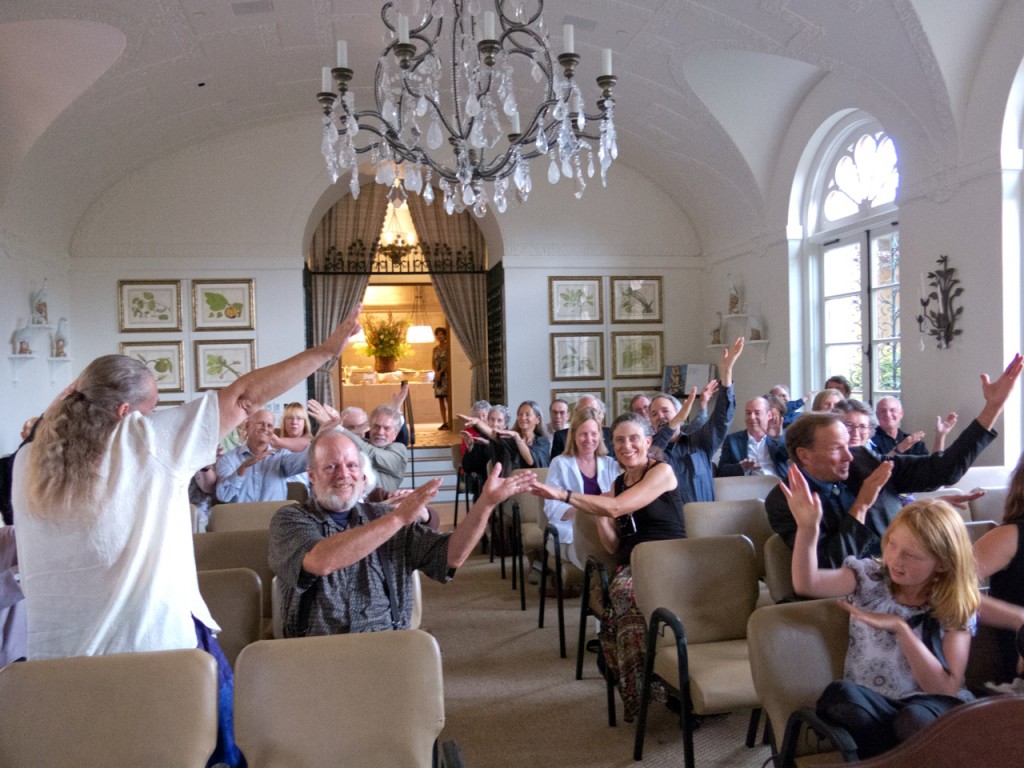
Slip Slide Salute to John C. Crowell
An informal reception followed the memorial. Plans were to have the guests spill into the adjoining courtyard but a light rain kept the gathering mostly inside. George Quirin played Flamenco guitar, a favorite of my father’s.
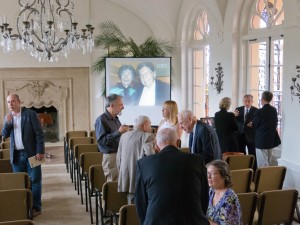
Power Point Presentation
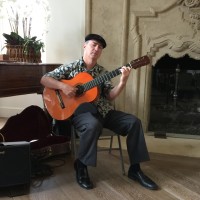
George Quirin – Flamenco Guitarist
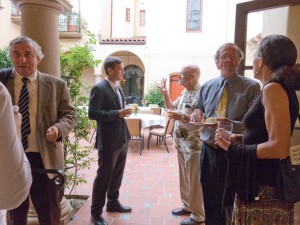
Courtyard Reception
Photo story boards of my father’s life and Julia Miller brings Crowell Troll memorabilia.
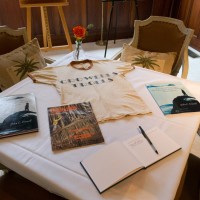
Crowell Troll memorabilia
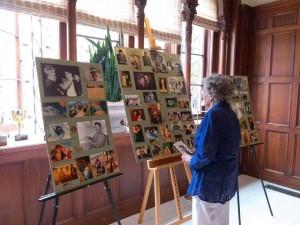
Photo Story Boards, Martha Pearl
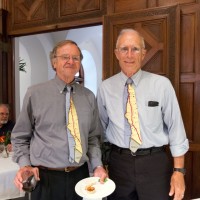
Keith Howard, Art Sylvester, San Andreas fault ties.
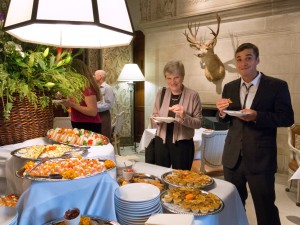
Reception Buffet, John Bobroskie, Jan Miller
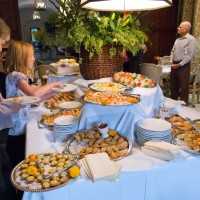
Memorial buffet table
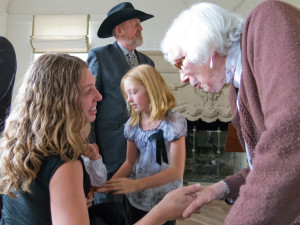
Memorial reception, Alisha McCormack, Molly McCormack, Scott Macklin and Ruth Beech
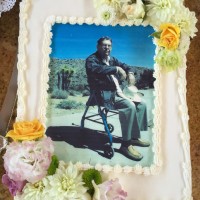
John Crowell, Photo Cake
Following the memorial we host a dinner in the formal dining room at Casa Dorinda. It is a lively gathering of geologists and family. I know my father would be pleased.
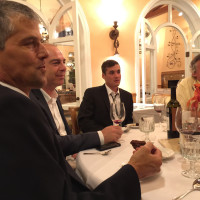
Geologist’s Table, Casa Dorinda
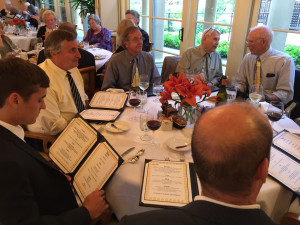
Geologist’s Table, Casa Dorinda
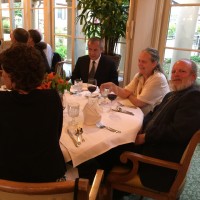
Family Table
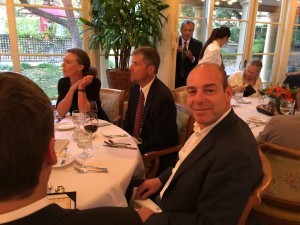
Geologist’s Table
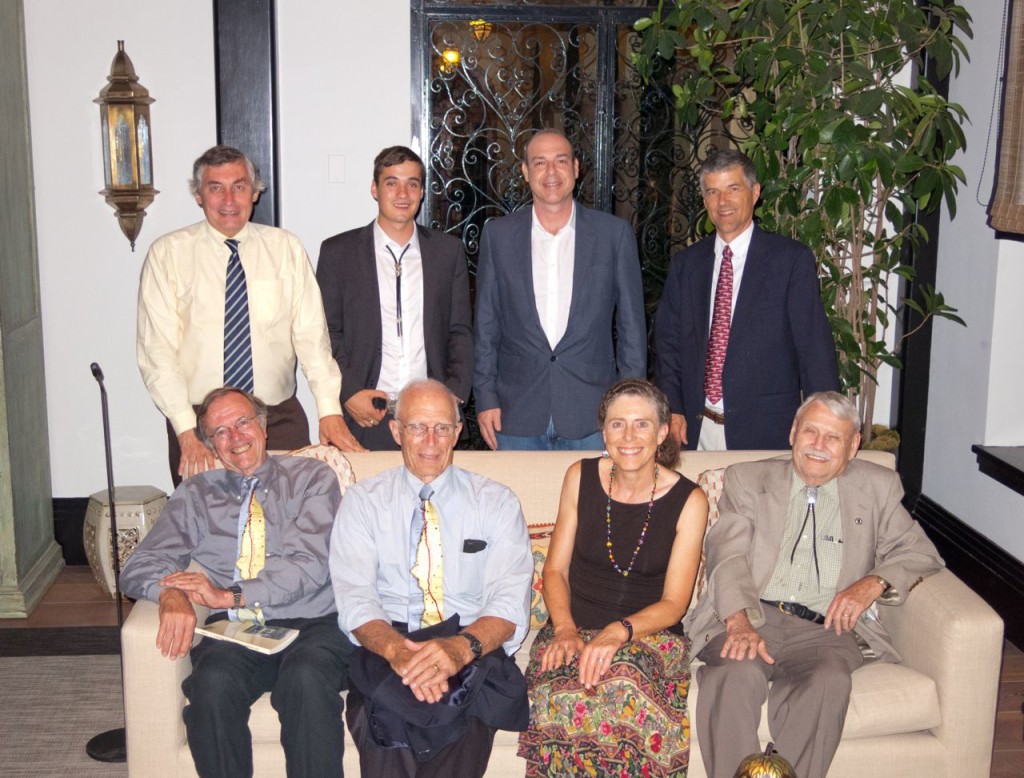
Geologist Group Photo
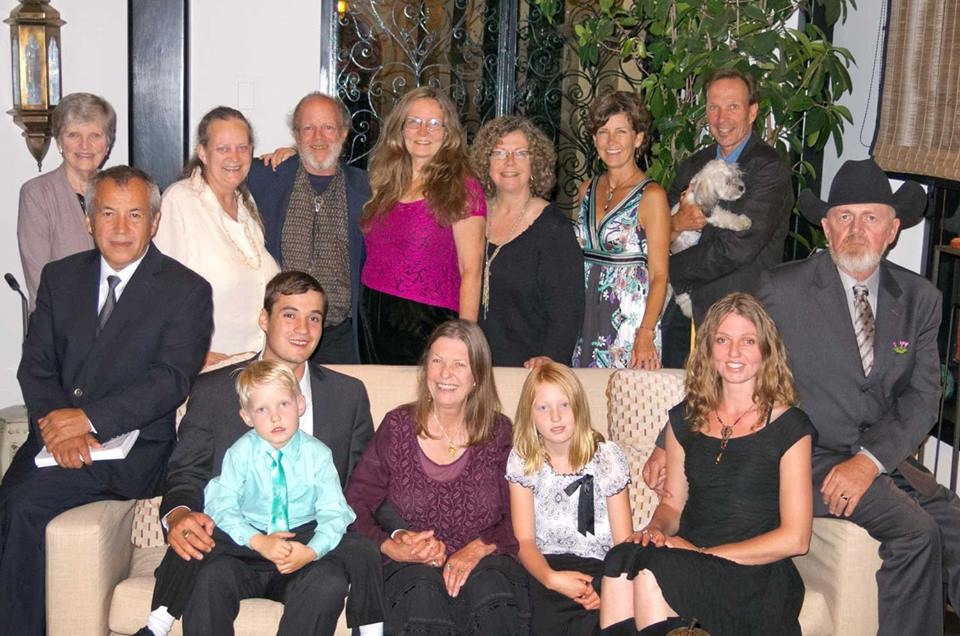
Family Group Photo
